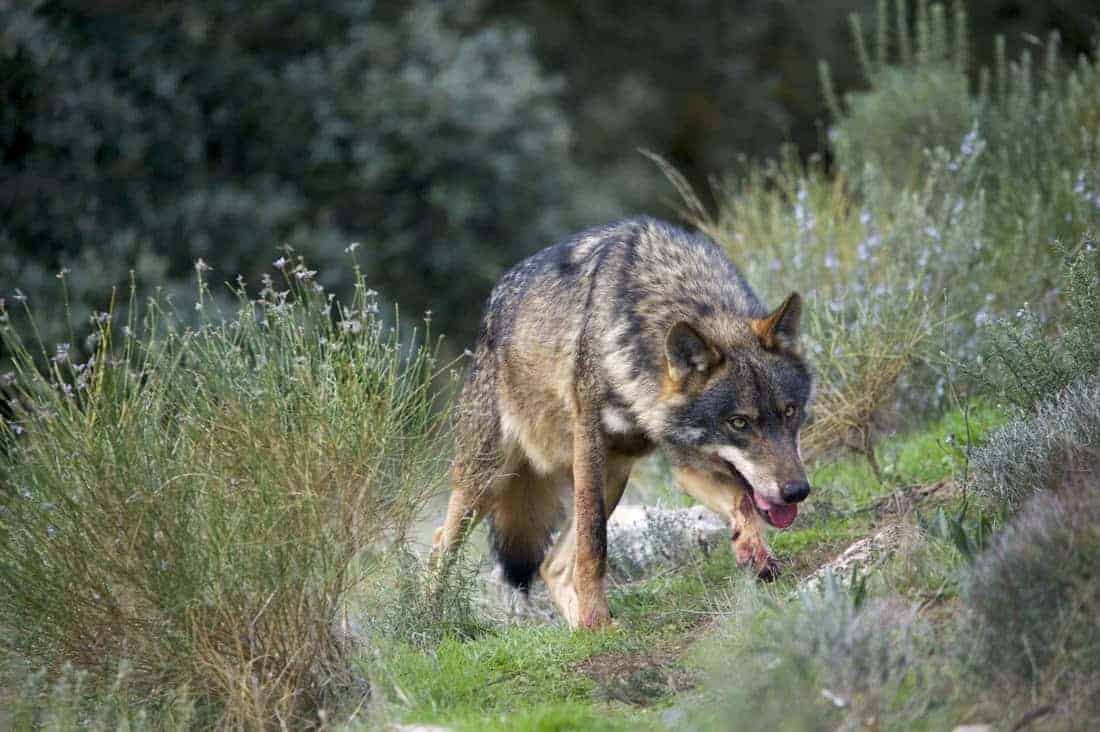Study confirms low percentage of dog and wolf crossbreeding in Swiss wolf population
The wolf has naturally recolonised the Alps in the last decades. But the wolf’s precense in a densly inhabited and used region, such as Central Europe, arises conflicts. Particularly, livestock owners and hunters oppose the comeback of the wolf. Many wolf opponents keep raising the argument of a high rate of crossbreeding, often falsely named hybridisation as a reason to shoot wolves. However, Swiss scientists came to the result that the dog introgression in the Swiss wolf population is very limited. This result debunks the argument that crossbreeding would be a problem in the alpine wolf population.
Please also read: Wolf crossbreds, friends or foe?
Roots of crossbreeding
Wolf-dog crossbreds have been reportet all over Europe. Particularly, crossbreds from male dogs and female wolves were subsequently integrated into wolf packs and backcrossed with wolves again. Several studies conducted in the last years took a closer look on the modality of wolf-dog hybridisation in the European wolf populations. Overall, the rate of crossbreeding strongly depends on the level of disturbances to the wolf populations. This particularly means the presence and abundance of feral and stray dogs, for example close to anthtopogenic environments. As expected the rate of hybridisation is low in Western Europe, with for example 0 to 6,5% across the Italian Appenines and the Iberian Peninsula. Eastern Europe on the other hand shows higher percentatges, with 10 to 14% in Georgia, Bulgaria and Greece. This can be lead back to the high number of free-ranging dogs.
Unclear legal status of crossbreds
The Bern Convention lists the Alpine wolf population as “endagered”. However, hybrids often fall into a legal gap. It is recommended to remove them in order to protect the integrity of wild wolf populations. The majority of the alpine wolves live in the Western parts of the Alpes between France and Italy. Only three packs established in Switzerland even though tens of individuals migrate thtrough the country every year. The rumor of wolf-dog hybrids is widespread in the public and is often used as a reason to minimise the wolf population. Debunking this argument is incredibly important to guarantee an objective discussion about the future wolf management and the wolf’s social preception in Switzerland.

Swiss scientists debunk rumour of wide-spread hybridisation
Scientists from the University of Lausanne conducted a long-term genetic survey of detected wolves in Switzerland and adjacent regions. The survey is part of an ongoing non-invasive genetic monitoring that started when the first wolves settled in the country, so more than 20 years ago. The scientists genotyped thousands of DNA samples and perfomed admixture analyses of genotypes of putative wolves and reference dogs. The objective was to estimate the hybridisation and admixture rate in the newly colonised Alpine wolf population. In the end the scientists were able to assign 1 645 samples of wolf salvia, faeces, blood, hair and tissue to 115 individuals. The samples of these individuals were collected between 1998 and 2017. The scientists then compared them with reference samples from 70 dogs.
The results of the study show that less than 2% of the animals had DNA that showed sings of crossbreeding. The two estimated cross-bread wolves were properly the outcome of a wolf and dog mating at least two generations ago. The three Swiss wolf packs show no signs of cross-breading with dogs. The results of this study are in line with previous similar studies from Italy and Spain. Luca Fumagalli, one of the researchers working on the project, says:
Our results prove that dog-wolf cross-breeding is very limited in reality, even anecdotal, and that the genetic integrity of wild wolf populations livin in the Alps remains intact.

The Swiss laws recommend the culling of crossbreds to preserve the integrity of the pure wild populations. However, Luca Fumagalli implies that controlling the presence of stray dogs that transfer their genes to wolves would be the crucial taks in keeping hybridisation low in the future.








Wolves are well-known to travel over hundreds, sometimes even thousands, of kilometres. Wolves in Switzerland arrived from the Apennine population in Italy, a country said to have over a million stray dogs roaming. As the study states in the discussion:
“Feral and stray dogs are supposedly absent in Switzerland, and wolves usually avoid the immediate vicinity of human settlements. All dogs detected here are doubtlessly pets, hunting or guarding dogs, the Swiss mountains being extensively hiked and exploited for pastoralism. Although local crossbreeding cannot be ruled out, these rare hybridization events may have rather occurred in the Apennines, the source population of Alpine wolves24,25. About a million of free-ranging dogs has been reported over Italy by perhaps outdated estimates (10% of feral individuals38,39). While the overall dog introgression rate of Italian wolves still remains low (<7%, Table 1), some localized areas host introgressed packs21. Among them, western Tuscany, at the northwestern edge of the Apennine population, appears to be a hotspot of wolf × dog hybridization20, near the corridor connecting the Apennines and the Alps. Alpine wolves thus seems to have avoided gene flow with dogs and admixed individuals, which is remarkable given the low numbers of effective founders that arrived in this human-dominated region (~1525).”
In addition, the data in Table 1 provides more proof that hybridisation rate in many countries is lower than the numbers claimed by people against their presence.
the reason is that Swiss people do not allow for their dogs to wander on their own, so in this country a number of stray dogs is minimal + the number of wolves in Switzerland is so low, that statistical chances for a succesful mating between dogs and wolves there is close to zero